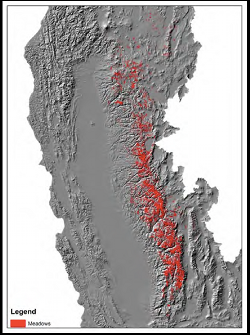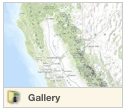Connectivity and Refugia in the Sierra Nevada
Are there places that buffer species from climate change? If so, where are they, and can species get there?

 Map of present-day meadows in the Sierra Nevada |
California natural resource managers need to develop climate change adaptation strategies to address the responses of species to warming trends, shifting precipitation regimes, and changes in vegetation communities. Climate change refugia -- areas that remain relatively stable as the climate changes -- are important to consider in adaptation planning, but little was known about the nature and distribution of these places. In the CA LCC-funded project "Determining Landscape Connectivity and Climate Change Refugia Across the Sierra Nevada", researchers mapped the meadows of the Sierra Nevada and used data on the persistence, stability, and genetic diversity of mammal populations to characterize the ability of the meadows to offer refuge to biodiversity. Incorporating landscape features such as availability of water, topography, and roads, the project team created a method to map well-connected meadows and examine the potential changes to those connections. They looked at how climate could change in those especially-valuable meadows in ways that affect their ability to provide quality habitat into the future. |
Conclusions from this research:
|
 Belding's Ground Squirrel, Urocitellus beldingi |
Available Data: |
Publications and Press Releases:
More information and products from this research effort can be found in the project page on the Climate Commons, or contact Toni Lyn Morelli, morellitlm@gmail.com. |
 Climate refugia workshop with resource managers |
Co-Production of Climate-smart Conservation Solutions
The key to successful implementation of climate-smart conservation solutions is collaboration between researchers and natural resource managers. Resource managers have been involved in the project from the design stage through a variety of workshops, beginning in May 2012 and continuing into 2014. In December 2013 and May 2014, two workshops were held with federal and state natural resource managers from the U.S. Forest Service, National Park Service, California Department of Fish and Wildlife, and U.S. Fish & Wildlife Service entitled Climate Adaptation Options for Natural Resource Managers in the Sierra Nevada. The goal of these workshops was to create an opportunity for managers to review the results, discuss their options for managing resources in the face of climate change, and determine how these products can inform on-the-ground decisions and aid climate adaptation actions. |
5/2017

